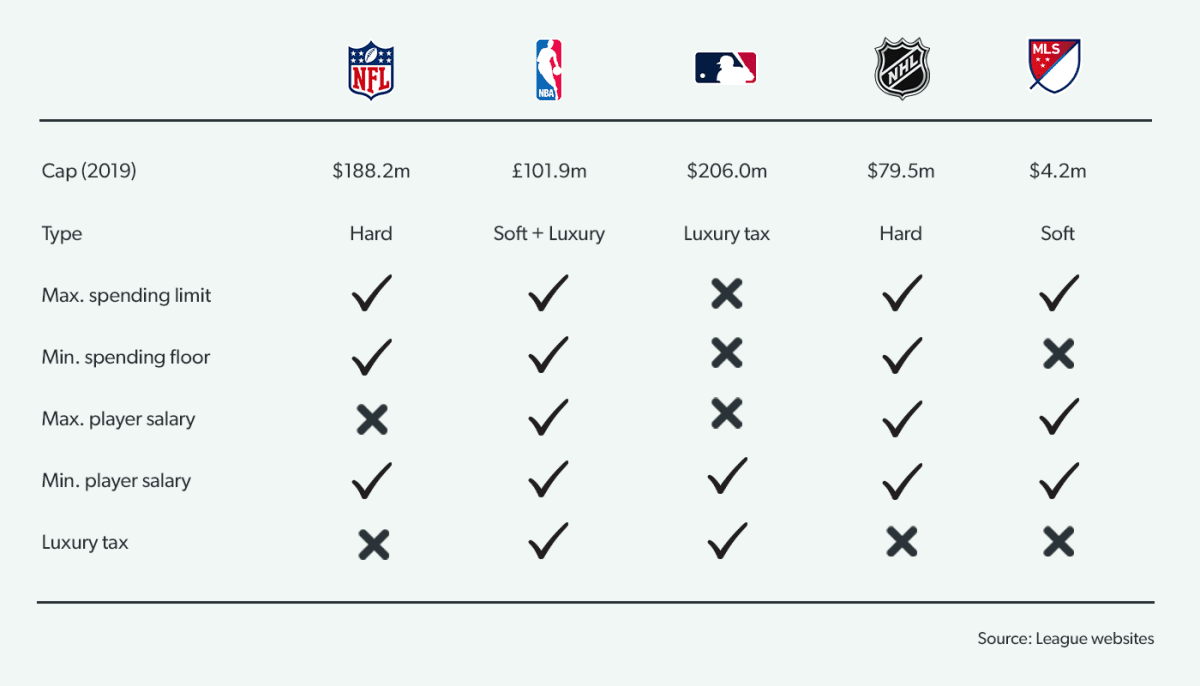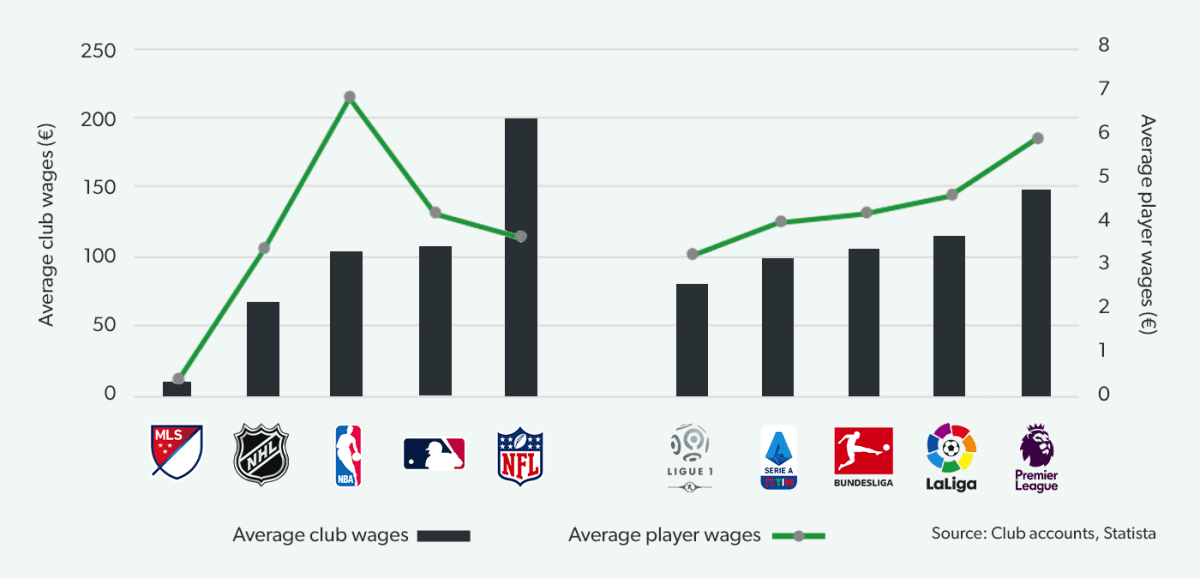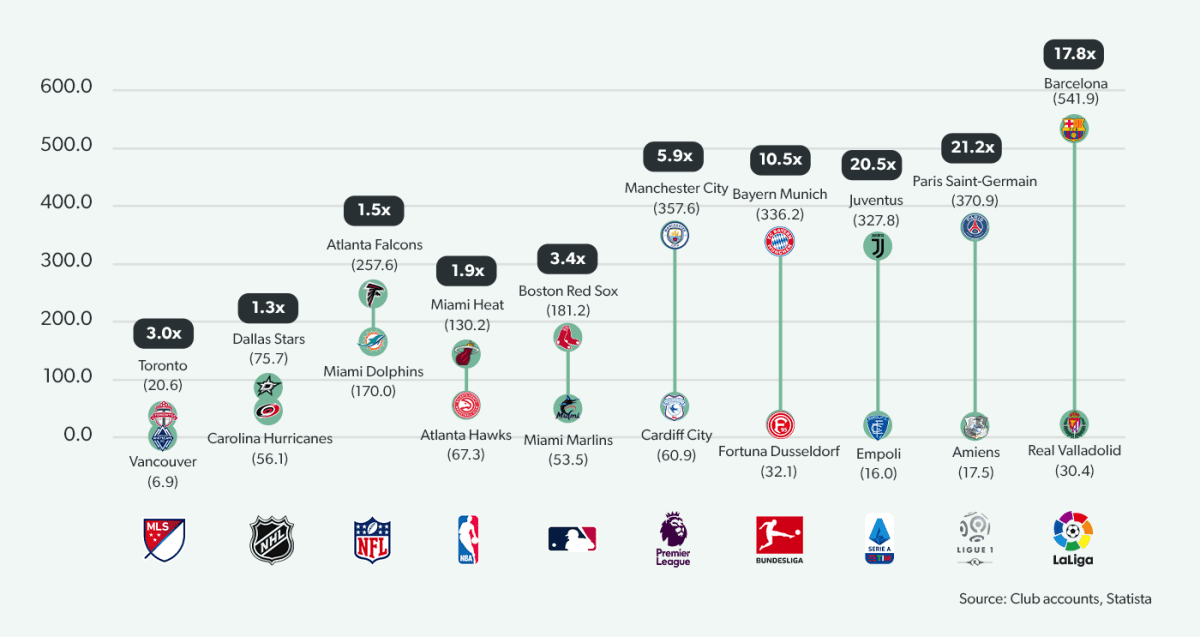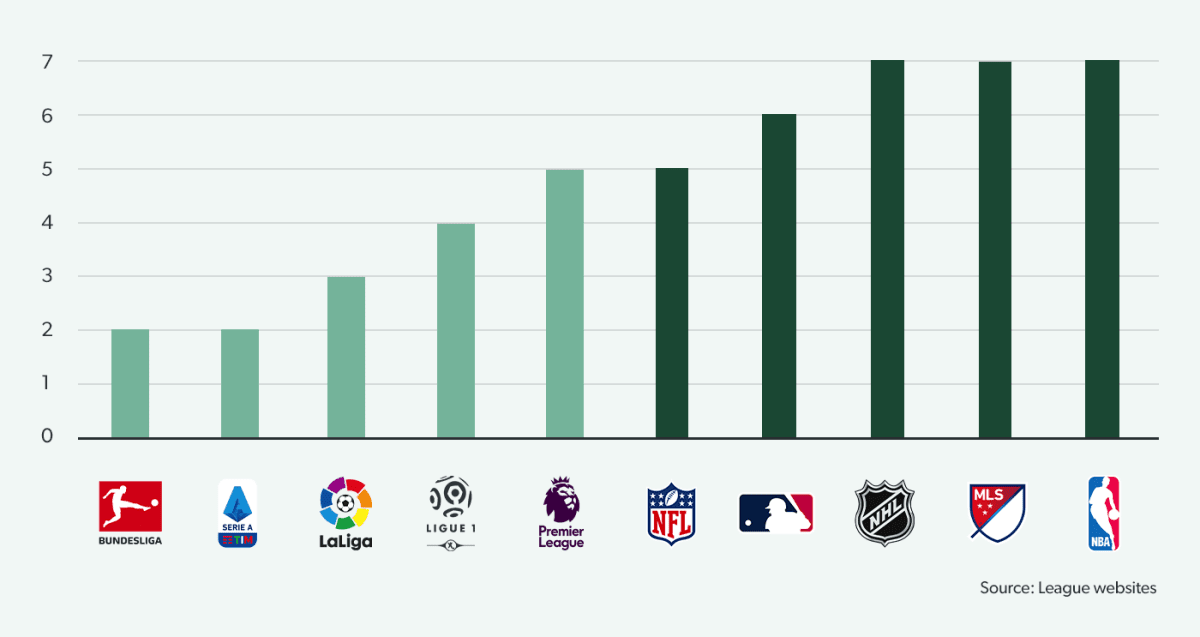As sports club revenues have plunged amid pandemic-induced ticketing revenue losses, player wages are understandable the subject of even more scrutiny than usual.
The spotlight is once again trained on players of the elite game, who have been accused – rightly or wrongly – of being out of touch with the struggles of the “ordinary” people being placed on reduced salaries through furlough schemes, or in the worst cases losing all their income. The debate over whether players earning several times more in a week than most of the population could hope to take home in a year has played out very publicly, with many advocating the introduction of restrictions to bring ever-increasing player pay under control – as well as for the benefit of the game through making clubs more financially sustainable.
In the last post, we looked into the major differences between the “Big-5” of North American sport and European football. One of the most interesting insights was around the greater equality of revenue distribution in North American leagues, which helps to maintain all clubs in as viable businesses and thereby protect the continuity of the league competition. Other key tools used to promote financial viability are the closed-league system – which eliminates the risk and downsides of relegation – and a greater use of wage controls.
Wage caps are common in North American sports. While they can place limitations on a league or team's ability to entice the most sought-after players, they have been shown to improve the sustainability and competitiveness of the division. With the mounting financial pressures of Covid-19 forcing many clubs and leagues to review wage structures, there has been much speculation around the introduction or further implementation of wage caps across the sports industry.
Wage restrictions are commonplace in North America
All of the top five sports leagues in North America have some kind of restrictions on wage spending, aimed at keeping costs down to support club profitability and sustainability and maintaining competitive balance by restricting richer clubs from signing more top players than their rivals. The NFL and NHL have hard caps – meaning strict upper and lower limits on spending, enforced with penalties. The NBA and MLS have soft caps – meaning they allow one or more exceptions, such as the MLS’s designated player rule (or “David Beckham rule”) which allows for up to 3 squad spots not subject to the cap to be allocated to higher-paid players. The MLB has adopted a “luxury tax” system (also present in the NBA), in which overspending vs. an agreed threshold is penalized through the imposition of a tax, the proceeds of which are redistributed into the other clubs in the league to help level the playing field, as well as into league development projects.

Lower wage spend disparity in North America
NFL clubs have an average wage bill of €200m, almost twice the size of the next two biggest US sports (Major League Baseball & the NBA) and more than twice the salaries of Serie A and Ligue 1 football. The second highest in absolute is the Premier League with average annual wages of €147m. The lowest wages in Europe are paid in France’s Ligue 1 (€80m per club), while the MLS has a wage bill of only €10m, only 5% of an NFL club.
On a per player basis, the NBA pays the highest at an average pay packed of €6.8m, based on primary registered players. With comparatively smaller squads than North American leagues, European football (with the exception of Ligue 1 in France) pays more on a per-player basis than the NFL, NHL, and MLS – an average of €4.7m. The NFL’s comparatively lower pay per player is due to a comparatively larger squad size of 55 players.

As with club revenues, the wage bill disparity between the top and bottom teams in North American sports is relatively minor, with top clubs paying an average of 2.2x the wages of bottom clubs. In the NHL, top payers the Dallas Stars pay only 1.3x the wages of lowest payers Carolina Hurricanes, while at the other end of the scale the MLB’s Boston Red Sox wages are 3.4x higher than those of the Miami Marlins. Again, in Europe the picture is very different. On average top clubs pay 15.2x more than bottom clubs, with the lowest factor being in the Premier League (Man City 5.9x the wages of Cardiff City) and the highest in Ligue 1 where PSG outspend Amiens by a factor of 21.2x.

Caps contribute to competition and profitability
Over the past 10 seasons, North American sports have had a higher number of different winning clubs than the European Big 5 football leagues. In the last decade, North American leagues have been won by an average of 6.4 different clubs – 7 in the NBA, MLS, and NHL, 6 in Major League Baseball, and 5 in the NFL. 12 different teams have appeared in the Super Bowl, while 13 different teams have made it to baseball’s World Series. By contrast in Europe, an average of 3.2 clubs have won the football leagues – the past decade has been dominated by just two clubs in Serie A and the Bundesliga and three in La Liga. Ligue 1 has been won by four clubs, while the Premier League has had the highest number of different clubs lift the trophy at five, making it the most competitive of the European Big 5.
In the past decade, North American leagues have been won by an average of 6.4 different clubs. By contrast in Europe, an average of 3.2 clubs have won the football leagues.

From a financial standpoint, the wage caps in place across the various leagues appear to play an effective role in cost control. In North American sport, wage bills are relatively low as a percentage of revenues, ranging from 37% in Major League Baseball to 54% in the NFL, with an average across the five leagues of 44%. In European Big 5 football, wages are 61% of revenues on average, with the highest in Ligue 1 at 73%. Bundesliga club revenues are generally published including player trading (excluded from other clubs) – with these revenues excluded the percentage would be higher still.

